Few pieces of equipment can claim to have propelled the popularity of backcountry skiing like Fritschi’s Freeride binding. It was the first alpine touring binding that appealed to the mindset of the relatively untapped market of American alpine skiers lusting for untracked powder, but unwilling to let go of their reliance on beefy alpine bindings.
In fact, it had to have been quite an internal struggle for Fritschi to even produce, what to them had to have been an antithetical backcountry binding. After you’ve spent even a modicum of time earning your turns you realize that there is a penalty for every extra pound you lug around, particularly on your feet.The basic configuration of the Fritschi Freeride had existed for years, first introduced as the Diamir. It quickly gained a following in Europe as a light weight plate binding that was a compromise for performance, but that compromise was made knowing that in the long run, weight is of paramount importance.
To the mind of a resort based American alpine skier, however, weight was synonymous with performance and lack of it meant a compromise in skiing enjoyment and safety. When Fritschi finally realized they had to embrace that mindset the Freeride was born (AD 2001). The growth of AT skiing has been on a steady climb ever since.
The Freeride has been so successful the light weight version, the Diamir Titanal III, was dropped from the line in ’03. It has also spawned even heavier versions from competitors, notably Marker. Even though Fritschi has recognized the importance of providing enough mass to satisfy new alpine converts, they haven’t forgotten this is a backcountry binding and other factors contribute to overall performance.
In a nutshell, what distinguishes the Freeride from other AT bindings is its backcountry versatility. It provides solid alpine ski performance and excellent touring in a classic, plate style design.
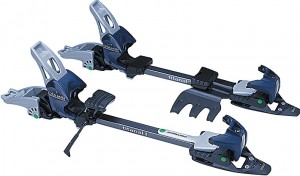
Bye bye Titanal. As good and light as a plate binding could get, but not solid enough for Americans.
For those demanding a rock solid connection with the ability to absorb the pounding of regular cliff hucking and moguls the Duke takes the hits in stride. Unfortunately the Freeride will not put up with that for long. It’ll hold you in a drop, but if air time is habitual maybe you should probably be snowboarding. 😉
However, if you don’t ski at the limits of control, don’t regularly huck 30 footers or even 10 footers, but just want a solid, reliable connection with a free heel for earning your turns you will be hard pressed to improve on the balance of performance the Diamir Freeride Pro offers.
Fritschi’s Diamir series of bindings, of which the Freeride is the premier model, has been steadily improved since it’s introduction in 1995. Today’s version of the Freeride provides far better transmission of power than ever, with more efficient touring than ever, at a very competitive price with few compromises. It may not seem like a big deal, but for the sake of simplicity it is hard to improve upon the mode switch of the Fritschi Diamir series. With your ski pole, pry the climbing post at the back of the binding up a click and the plate swings free at the toe for a full 45° range of motion. The binding can actually pivot a bit more than 45°, but not without adding some resistance to your stride. For the majority of cases though 45° is plenty.
Pull that heel post up another click and you have a nice, moderately aggressive climbing post with nearly 2″ of heel lift (~50mm), or 9° of compensation, or pull it all the way up for stiletto mode and 13° or 3-3/8″ (85mm) of heel lift when you just want to head straight up without stretching your calves.
To lock the heel again, push the climbing post down until the plate slips in, then press it all the way flat to lock it down. Unlike Tech bindings or the Duke, you don’t need to step out of your binding to switch between modes, something you will definitely appreciate when you need to kick n’ glide across the meadow at the base of the slope.
Less obvious is the change in the pivot position for touring. It has been moved rearward a full half inch (12.7 mm), putting it further back than even the pivot point of Tech bindings. Actually there is more to it than just moving the pivot, which Fritschi calls their Gliding Technology. This delivers a more efficient stride, allowing you to step forward with an effective pivot point more under your big toe, rather than in front of it. This change occurred two seasons ago (’09/’10). Over the years the Freeride has steadily improved its torsional rigidity by increasing the width of the support feet on the heel, and adding wishbone shaped ribs on either side of the toe. The effect of these combined changes they call Power Transmission Control Technology. To accommodate this increased width the mounting pattern under the toe was modified. This increased width in the mounting pattern not only improves torsional rigidity for delivering solid edge hold while turning, but also when traversing an icy slope on the uphill leg.
Another benefit of the current models in Fritschi’s Diamir series is the ability to be used with almost any alpine ski boot. The toe height is adjustable to accommodate most any alpine boot with a sliding anti-friction plate for boots with lugged soles. While Marker bindings may offer higher release values, anything above DIN 12 is not truly DIN certified, and below 12, Marker’s bindings are not DIN certified in combination with lug soled boots.
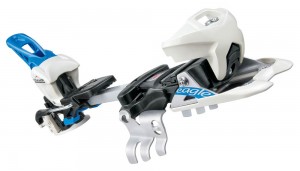
Fritschi's Eagle with the Axion crampon engaged. It flips back 180 degrees to disengage. The main difference between the Eagle and Freeride is the absence/presence of the wider feet under the heel.
Optional crampons are also available, making this a full featured backcountry binding. To put the crampons on you need to have your foot out of the binding. Starting in 2010 Fritschi offered the Axion crampon with a modified attachment that allows you to mount them to the plate, then pivot them up and out of the way so that they are disengaged, yet ready for easy deployment. Half the reason people don’t bother with ski crampons is that they require a dedicated gear break to add or remove. Not with the Axion that works on either the Freeride or Eagle. Snap ’em on at the beginning of the tour, but flip ’em upside down until you need ’em. Conclusion
More than ever, if this is your first season of backcountry there are only two reasons not to get Fritchi’s Freeride (or Eagle). Either you know you’re gonna love the sport and you have faith Dynafit is worth the extra bucks, or you’re a hucker. Outside of those reasons, you’ll have very few regrets with this binding. You won’t need to buy new boots and you’ll be glad you took the step to get outside the boundaries and start experiencing the satisfaction that only comes from earning your turns. If you graduate to a lighter binding later on, keep your Freerides mounted and ready to loan to friends who need to be convinced that yes, earning turns really is as good as you’ve been telling ’em it is.
Fritschi
Freeride
MSRP: $ 500
Weight/pr: 4 lbs. 8 oz. (2.2 kg)
Sizes: S – 260-315 mm • M – 285-340 mm • L – 330-365 mm
Eagle
MSRP: $ 440
Weight/pr: 4 lbs. 7 oz. (2 kg)
Sizes: S – 260-315 mm • M – 285-340 mm • L – 330-365 mm
© 2011
Are you a Fritschi user? What’s your Diamir experience? Any things to be concerned about that were missed?

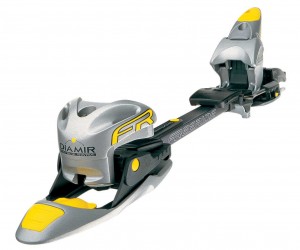
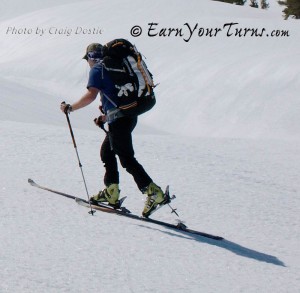
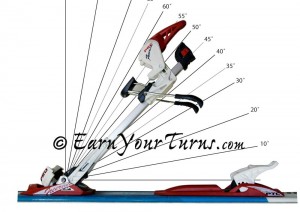
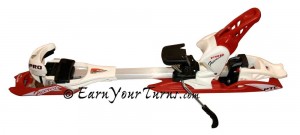
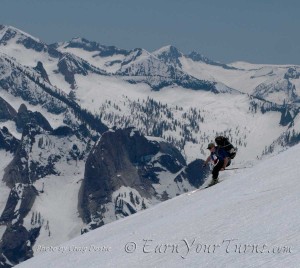
7 pings
Skip to comment form
[…] years ago Dynafit reps were lamenting the rise in popularity of the Fritschi Freeride. Interest in the US was just starting to pick up for Dynafit system and it seemed like the Freeride […]
[…] touring efficiency. The closest plate binding in weight and functionality is Fritschi’s Freeride. By comparison the Onyx is lighter, laterally more rigid, and it eliminates lifting the entire […]
[…] heel without exiting the binding. Please note, however, the switch is not as easy to operate as the Freeride and takes a bit of force to open far enough to lift your heel. Nothing that won’t get easier […]
[…] standard soles. Fritschi led the charge to appeal to alpine converts with their paradigm shifting Freeride binding. At the time it was the heaviest plate binding available that allowed resort skiers to use […]
[…] heavyweights, but is still a heavyweight. It’s still a pound heavier than Fritschi’s Freeride, but frees the heel nearly as easy, making mode changes fast and worthwhile for short flat […]
[…] Fritschi Freeride Pro […]
[…] easy the mode switch was to operate; on par with the original BAT binding, Fritschi-Diamir’s Freeride. No need to step out of the binding to switch modes, a nice feature between downhill pitches where […]